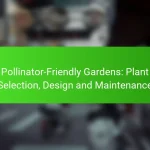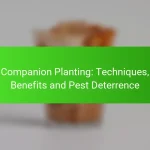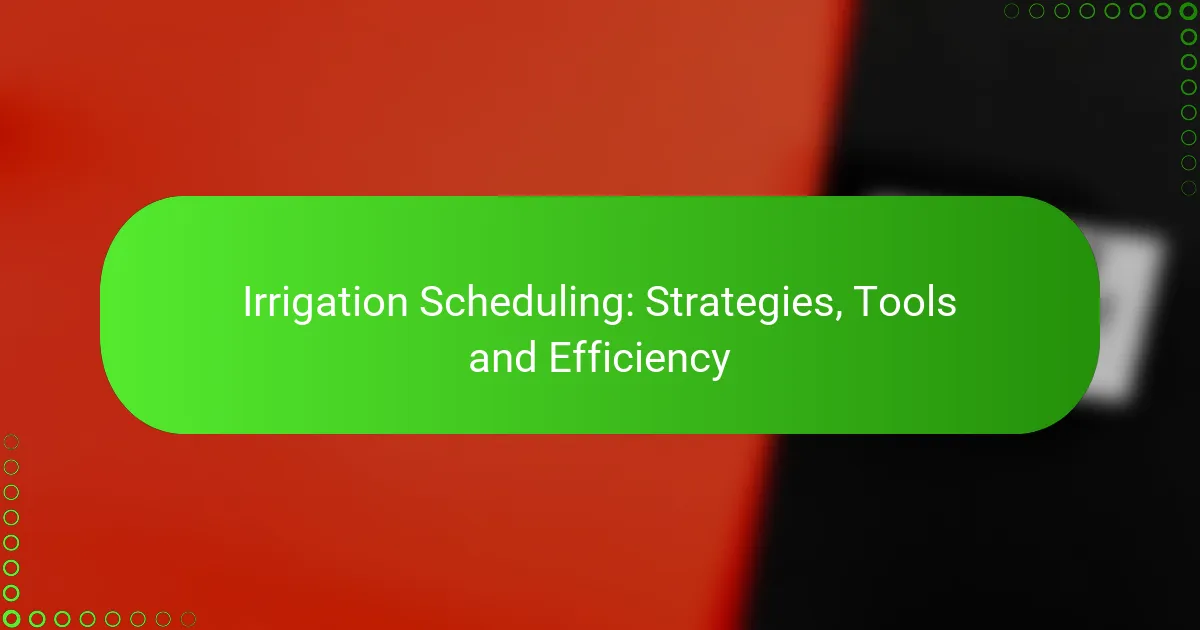Drought-resistant plants are specially adapted species that thrive with minimal water, making them perfect for arid climates or areas facing water scarcity. By selecting native plants that require less maintenance and are well-suited to local conditions, gardeners can enjoy the benefits of reduced water usage and lower upkeep costs while promoting sustainable landscaping practices.

What are drought-resistant plants?
Drought-resistant plants are species that can survive and thrive with minimal water. They possess adaptations that allow them to conserve moisture and withstand dry conditions, making them ideal for arid climates or regions experiencing water scarcity.
Definition of drought-resistant plants
Drought-resistant plants, often referred to as xerophytes, have evolved specific traits to minimize water loss. These adaptations may include thick, waxy leaves, deep root systems, and the ability to store water. Such characteristics enable them to endure prolonged periods without rainfall.
Understanding these plants is crucial for gardeners and landscapers looking to create sustainable gardens that require less irrigation. By selecting drought-resistant varieties, one can reduce water usage and maintenance efforts while still enjoying a vibrant landscape.
Examples of drought-resistant plants in South Africa
South Africa is home to a variety of drought-resistant plants well-suited to its diverse climates. Some popular examples include the Aloe species, such as Aloe ferox and Aloe vera, which are known for their water-storing capabilities and medicinal properties.
Other notable drought-resistant plants include the indigenous Spekboom (Portulacaria afra), which can thrive in poor soil conditions and is effective for carbon sequestration. Additionally, the Cape fynbos region features many resilient species like the Leucadendron and Protea, which are adapted to survive in low-water environments.
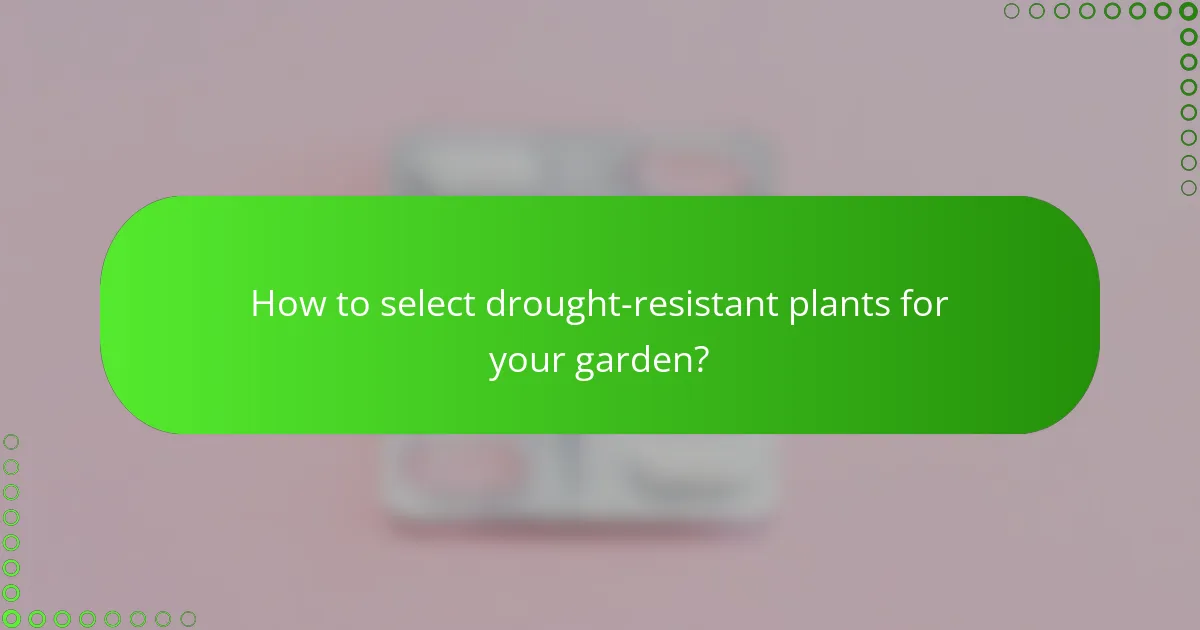
How to select drought-resistant plants for your garden?
Selecting drought-resistant plants involves choosing species that thrive in low-water conditions and can withstand periods of dryness. Focus on native plants, as they are often well-adapted to local climates and require less maintenance.
Factors to consider in plant selection
When selecting drought-resistant plants, consider the local climate, soil type, and sunlight exposure. Native plants typically require less water and are more resilient to local pests and diseases.
Evaluate the mature size of the plants to ensure they fit your garden space. Grouping plants with similar water and light needs can simplify care and enhance overall garden health.
Top drought-resistant plants for different climates
In arid regions, consider succulents like agave and cacti, which store water in their leaves. For temperate climates, plants such as lavender and sedum are excellent choices, providing beauty while requiring minimal water.
In humid areas, look for plants like coneflowers and black-eyed Susans, which can tolerate dry spells but thrive in moisture. Always check local gardening resources for specific varieties that perform well in your area.
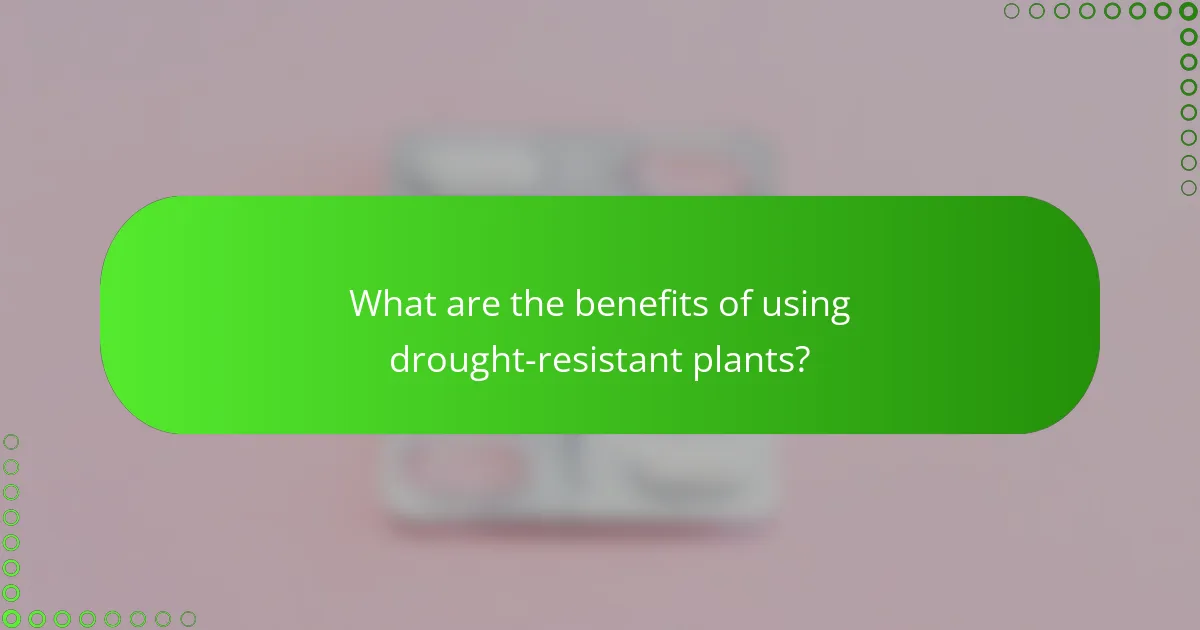
What are the benefits of using drought-resistant plants?
Drought-resistant plants offer significant advantages, including reduced water usage and lower maintenance costs. These plants are specially adapted to survive in arid conditions, making them ideal for sustainable gardening and landscaping.
Water conservation benefits
Using drought-resistant plants can lead to substantial water savings, as they require less irrigation compared to traditional plants. Many of these species can thrive on natural rainfall, which can be particularly beneficial in regions prone to water shortages.
For example, native plants often have deep root systems that access moisture from deeper soil layers. This adaptation not only conserves water but also reduces the frequency of watering, allowing gardeners to focus on other tasks.
Environmental impact of drought-resistant plants
Drought-resistant plants contribute positively to the environment by promoting biodiversity and reducing the need for chemical fertilizers and pesticides. Their resilience helps maintain healthy ecosystems, which support various wildlife species.
Additionally, these plants can help prevent soil erosion and improve soil health by maintaining ground cover. By selecting local drought-resistant varieties, gardeners can create habitats that are more in tune with their regional climate and ecology.
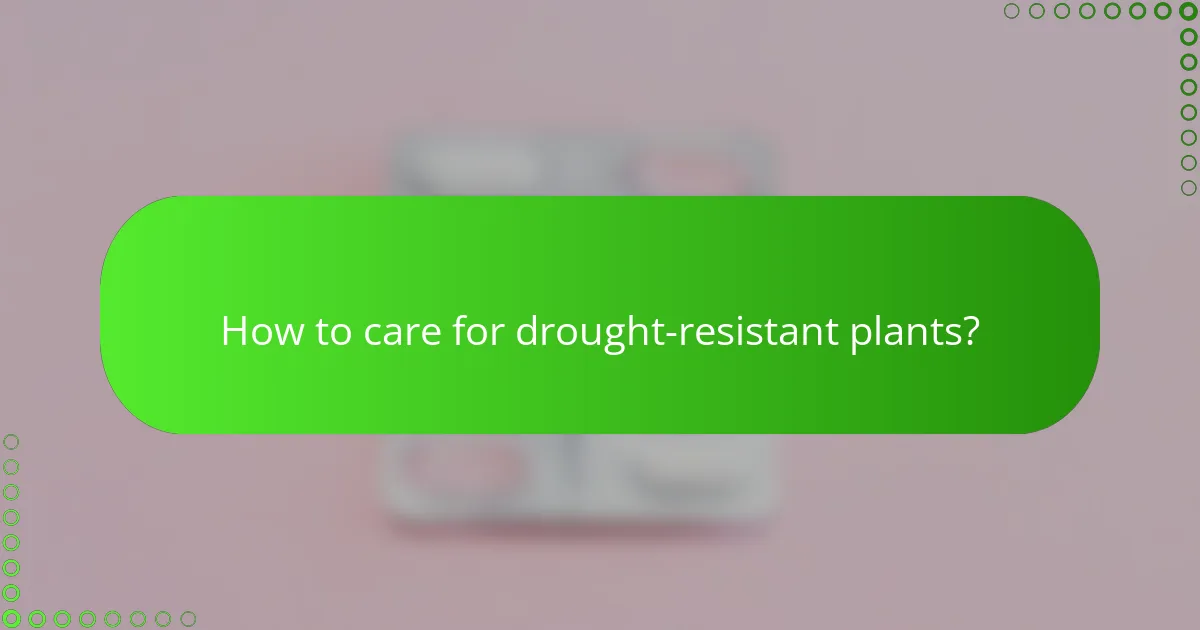
How to care for drought-resistant plants?
Caring for drought-resistant plants involves understanding their specific needs for water, soil, and sunlight. These plants are adapted to survive with minimal water, but proper care can enhance their health and longevity.
Watering techniques for drought-resistant plants
Watering drought-resistant plants requires a strategic approach to ensure they thrive without overwatering. Deep watering is preferable, allowing the soil to absorb moisture thoroughly, which encourages deeper root growth. Aim to water these plants once every week or two, depending on the climate and soil type.
It’s best to water early in the morning or late in the afternoon to minimize evaporation. Using mulch around the base of the plants can help retain soil moisture and reduce the frequency of watering.
Soil preparation for drought-resistant gardening
Preparing the soil for drought-resistant gardening is crucial for plant success. Start by ensuring good drainage, as waterlogged soil can harm these plants. Incorporate organic matter, such as compost, to improve soil structure and enhance moisture retention.
Testing the soil pH can also be beneficial; most drought-resistant plants prefer slightly acidic to neutral soil (pH 6.0 to 7.0). Adjusting the soil with amendments can create an optimal environment for growth.
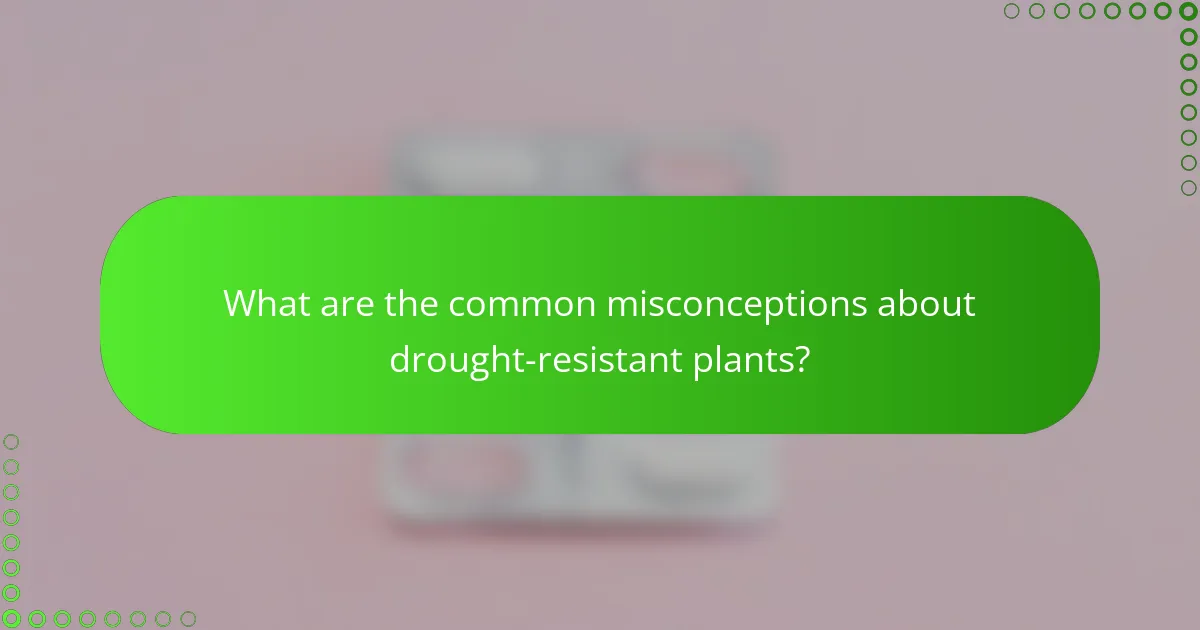
What are the common misconceptions about drought-resistant plants?
Many people mistakenly believe that drought-resistant plants require no water and are less attractive than traditional plants. Understanding these misconceptions can help gardeners make informed choices about their landscaping and plant care.
Misconception one: They don’t need any water
A common belief is that drought-resistant plants thrive without any water. In reality, these plants are adapted to survive with less water, but they still need some moisture, especially during establishment and extreme heat. Regular watering, particularly in the first few months after planting, is crucial for their long-term health.
It’s important to monitor soil moisture and provide supplemental irrigation during prolonged dry spells. A good rule of thumb is to water deeply but infrequently, allowing the soil to dry out between watering sessions. This encourages deep root growth, which enhances drought tolerance.
Misconception two: They are not as beautiful
Another misconception is that drought-resistant plants lack aesthetic appeal. In fact, many drought-tolerant species are not only beautiful but also diverse in color, shape, and texture. Plants like lavender, succulents, and ornamental grasses can create stunning landscapes while conserving water.
When selecting drought-resistant plants, consider incorporating a variety of species to enhance visual interest. Grouping plants with complementary colors and textures can create a vibrant garden that is both attractive and sustainable. Additionally, many native plants are drought-resistant and can thrive in local conditions, further enhancing their beauty while supporting local ecosystems.
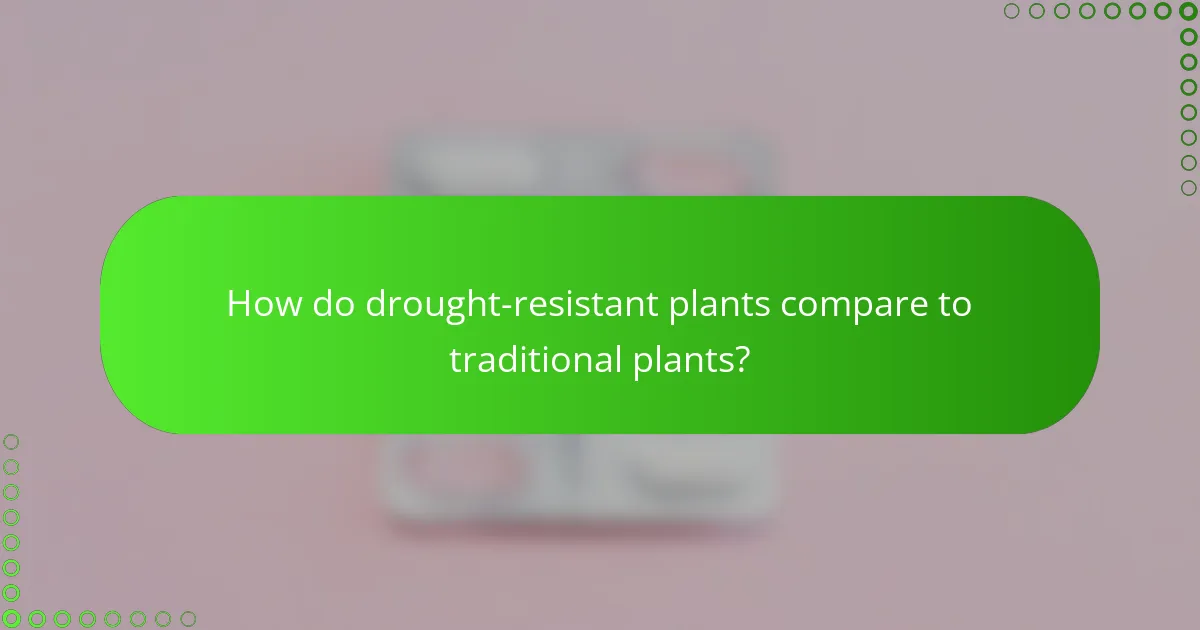
How do drought-resistant plants compare to traditional plants?
Drought-resistant plants are specifically adapted to survive with minimal water, making them more resilient than traditional plants in arid conditions. They typically require less irrigation and can thrive in poor soil, which reduces maintenance and resource consumption.
Growth rates of drought-resistant vs traditional plants
Drought-resistant plants often have slower initial growth rates compared to traditional plants, particularly in the early stages of development. However, once established, they can maintain steady growth even in low-water conditions, while traditional plants may struggle or require more frequent watering.
For example, succulents and native grasses may take longer to reach maturity but can survive prolonged dry spells, whereas traditional garden plants might exhibit rapid growth but will need consistent moisture to thrive.
Maintenance requirements comparison
Drought-resistant plants generally have lower maintenance needs than traditional plants, as they are designed to withstand dry conditions. This means less frequent watering, reduced fertilizer requirements, and lower susceptibility to pests and diseases.
When selecting plants for a garden, consider incorporating drought-resistant species to minimize labor and resource use. It’s advisable to group these plants together to create a sustainable landscape that thrives with minimal intervention.
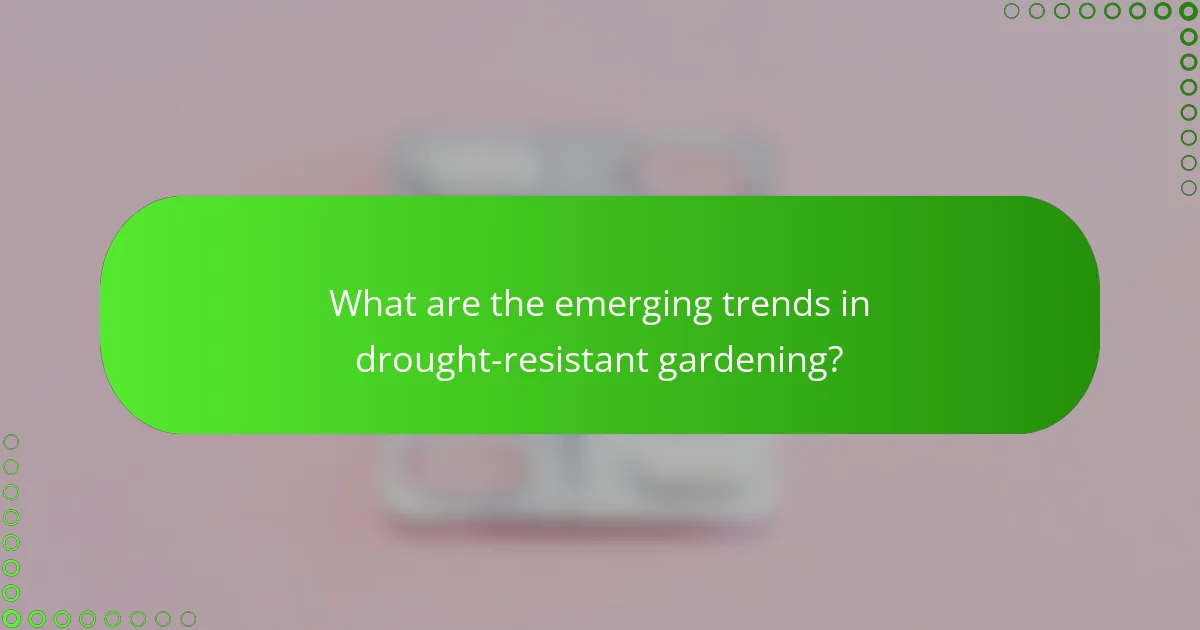
What are the emerging trends in drought-resistant gardening?
Emerging trends in drought-resistant gardening focus on selecting plants that thrive with minimal water and utilizing innovative techniques to enhance water efficiency. These trends are increasingly important as climate change intensifies water scarcity in many regions.
Innovative drought-resistant plant varieties
New plant varieties are being developed to withstand dry conditions while maintaining aesthetic appeal and functionality in gardens. For example, native plants such as succulents and certain grasses are being favored for their natural resilience and low water needs.
Hybrid plants that combine traits from multiple species are also gaining popularity. These hybrids often exhibit enhanced drought tolerance and can adapt to various soil types, making them suitable for diverse gardening environments.
Technological advancements in drought-resistant gardening
Technological innovations are transforming how gardeners approach drought-resistant practices. Smart irrigation systems, which use sensors to monitor soil moisture levels, help optimize water usage by delivering precise amounts of water only when needed.
Additionally, advancements in soil management techniques, such as the use of moisture-retaining polymers and mulching, contribute to improved water retention in the soil. These methods not only reduce water consumption but also enhance plant health and growth in arid conditions.



